A Place Where No Human Being Can Exist
How can a person make up for seven decades of misrepresentation and willful distortion in the time allotted to a sound bite?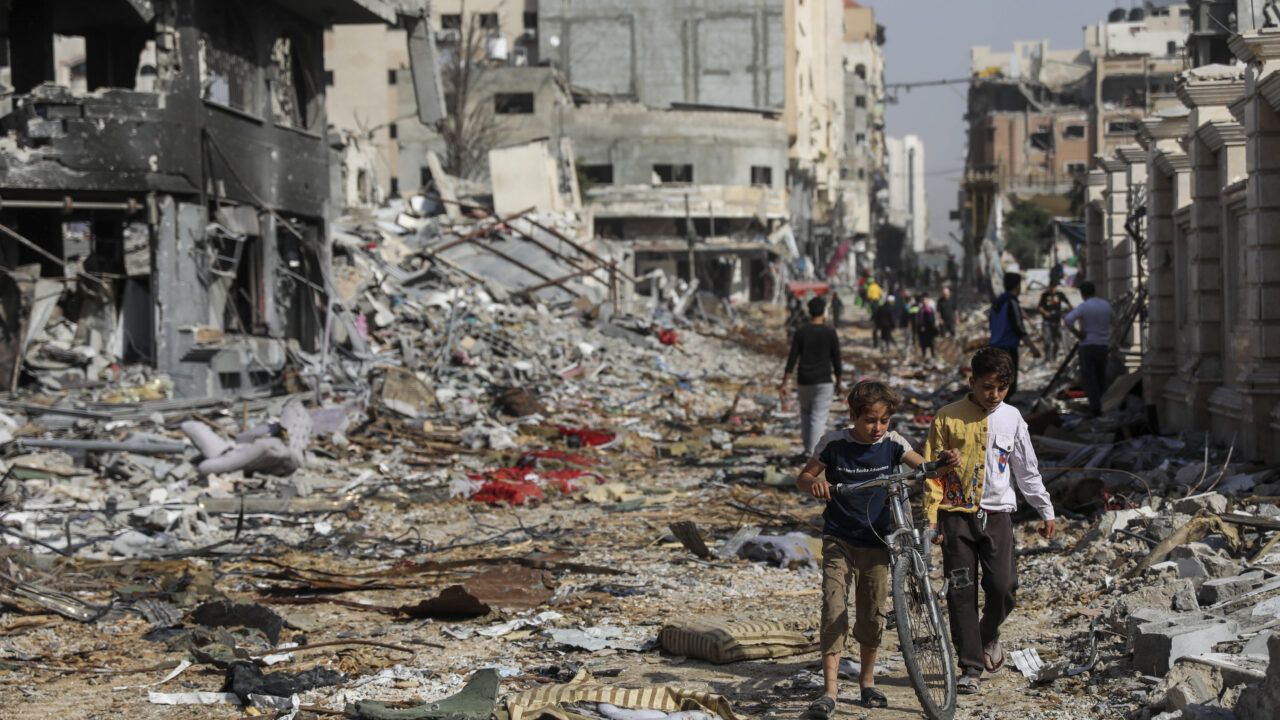 Palestinians walk through destruction in Gaza City on Friday, Nov. 24, 2023. (AP Photo/Mohammed Hajjar)
Palestinians walk through destruction in Gaza City on Friday, Nov. 24, 2023. (AP Photo/Mohammed Hajjar)
Recently, an Australian-Palestinian friend of mine was invited to appear on Australia’s national television network to discuss the situation in and around Gaza.1 His white interviewers posed all the usual questions: Can you defend what we’ve seen from Hamas militants? How has the Palestinian cause been helped by this violence? How can anyone defend the slaughter of young music lovers at a music festival? Do you defend Hamas? They probably expected a defensive reaction from him, but calmly, in his smooth Australian-accented English, my friend had already turned the interview on its head. “I want to know why I’m here today, and why I haven’t been here for the past year,” he said gently. By the eve of October 7, he pointed out, Israeli forces had already killed more than two hundred Palestinians in 2023. The siege in Gaza was more than sixteen years old, and Israel had been operating outside international law for seventy-five years. “Normal” in Palestine was a killing a day—yet a killing a day in a decades-old occupation was hardly news; it certainly wasn’t justification for a live interview on a national television network. Palestinians were being given the opportunity to speak now because the Western media suddenly cared, and they cared (“as we should care,” my friend added) because, this time, the victims included Israeli civilians. In the days after October 7, Australia made a strong show of support for Israel: Parliament and the Sydney Opera House were lit up in the colors of the Israeli flag; the Prime Minister said pro-Palestinian rallies should be called off out of respect for the Israeli dead; the foreign minister was lambasted for saying Israel should endeavor to minimize civilian deaths in Gaza. “Well, what about our lives?” my friend asked.
What about lighting up a building for us? When our government lights up every building blue and white, how are we [Australian Palestinians] supposed to feel? Are we not Australian? Should nobody care about us? A 14-year-old boy was set on fire in the West Bank by Israeli settlers. What about us?
The news anchors were caught off guard. This isn’t how these interviews are supposed to go.
Those of us, like my friend, who are summoned by Western media outlets to provide a Palestinian perspective on the disaster unfolding in Gaza are well aware of the condition on which we are allowed to speak, which is the tacit assumption that our people’s lives don’t matter as much as the lives of the people who do. Questions are framed by the initial Hamas attack on Israeli civilians (the Hamas attack on Israeli military targets and Israel’s belt of fortifications, watchtowers, and prison gates surrounding Gaza goes unnoticed), and any attempt to place it in a wider historical framework gets diverted back to the attack itself: How can you justify it? Why are you trying to explain it instead of condemning it? Why can’t you just denounce the attack? If Palestinian commentators want to be asked about Israeli violence against Palestinian civilians—about the history of ethnic cleansing and apartheid that produced the contemporary Gaza Strip and the violence we are witnessing today; about the structural violence of decades of Israeli occupation that cuts farmers off from their fields, teachers from their classrooms, doctors from their patients, and children from their parents—we have to ask to be asked. And even then, the questions don’t come.
“Normal” in Palestine was a killing a day—yet a killing a day in a decades-old occupation was hardly news.
I’ve spoken to a lot of journalists from a lot of different media organizations over the past two weeks. With rare exceptions, the pattern is consistent, as it has been for years. A recent appearance on a major US cable news channel was canceled at the last minute, immediately after I sent in the talking points the producer requested I submit; they clearly weren’t the talking points they had in mind. For years, I was on the list of regular guests for BBC radio and television interviews concerning Palestine—until, during a previous Israeli bombardment of Gaza, I told the interviewer he was asking the wrong questions and that the questions that mattered had to do with history and context, not just what was happening right now. That was my last appearance on the BBC.
How can a person make up for seven decades of misrepresentation and willful distortion in the time allotted to a sound bite? How can you explain that the Israeli occupation doesn’t have to resort to explosions—or even bullets and machine-guns—to kill? That occupation and apartheid structure and saturate the everyday life of every Palestinian? That the results are literally murderous even when no shots are fired? Cancer patients in Gaza are cut off from life-saving treatments.2 Babies whose mothers are denied passage by Israeli troops are born in the mud by the side of the road at Israeli military checkpoints. Between 2000 and 2004, at the peak of the Israeli roadblock-and-checkpoint regime in the West Bank (which has been reimposed with a vengeance), sixty-one Palestinian women gave birth this way; thirty-six of those babies died as a result.3 That never constituted news in the Western world. Those weren’t losses to be mourned. They were, at most, statistics.
What we are not allowed to say, as Palestinians speaking to the Western media, is that all life is equally valuable. That no event takes place in a vacuum. That history didn’t start on October 7, 2023, and if you place what’s happening in the wider historical context of colonialism and anticolonial resistance, what’s most remarkable is that anyone in 2023 should be still surprised that conditions of absolute violence, domination, suffocation, and control produce appalling violence in turn. During the Haitian revolution in the early 19th century, former slaves massacred white settler men, women, and children. During Nat Turner’s revolt in 1831, insurgent slaves massacred white men, women, and children. During the Indian uprising of 1857, Indian rebels massacred English men, women, and children. During the Mau Mau uprising of the 1950s, Kenyan rebels massacred settler men, women, and children. At Oran in 1962, Algerian revolutionaries massacred French men, women, and children. Why should anyone expect Palestinians—or anyone else—to be different? To point these things out is not to justify them; it is to understand them. Every single one of these massacres was the result of decades or centuries of colonial violence and oppression, a structure of violence Frantz Fanon explained decades ago in The Wretched of the Earth.
What we are not allowed to say, in other words, is that if you want the violence to stop, you must stop the conditions that produced it. You must stop the hideous system of racial segregation, dispossession, occupation, and apartheid that has disfigured and tormented Palestine since 1948, consequent upon the violent project to transform a land that has always been home to many cultures, faiths, and languages into a state with a monolithic identity that requires the marginalization or outright removal of anyone who doesn’t fit. And that while what’s happening in Gaza today is a consequence of decades of settler-colonial violence and must be placed in the broader history of that violence to be understood, it has taken us to places to which the entire history of colonialism has never taken us before.
* * *
At any moment, without warning, at any time of the day or night, any apartment building in the densely populated Gaza Strip can be struck by an Israeli bomb or missile. Some of the stricken buildings simply collapse into layers of concrete pancakes, the dead and the living alike entombed in the shattered ruins. Often, rescuers shouting “hadan sami’ana?” (“can anyone hear us?”) hear calls for help from survivors deep in the rubble, but without heavy lifting equipment all they can do is helplessly scrabble at the concrete slabs with crowbars or their bare hands, hoping against hope to pry open gaps wide enough to get survivors or the injured out. Some buildings are struck with such heavy bombs that the ensuing fireballs shower body parts and sometimes whole charred bodies—usually, because of their small size, those of children—over surrounding neighborhoods. Phosphorus shells, primed by Israeli gunners to detonate with airburst proximity fuses so that incendiary particles rain down over as wide an area as possible, set fire to anything flammable, including furniture, clothing, and human bodies. Phosphorus is pyrophoric—it will burn as long as it has access to air and basically can’t be extinguished. If it makes contact with a human body it has to be dug out by scalpel and will keep burning into the flesh until it’s extracted.
What we are not allowed to say, as Palestinians speaking to the Western media, is that all life is equally valuable. That no event takes place in a vacuum.
“We live,” one of Al Jazeera’s Arabic correspondents said, talking over the ubiquitous buzz of Israel’s lethal drones, “enveloped in the smell of smoke and death.” Entire families—twenty, thirty people at a time—have been wiped out. Friends and relatives desperately checking on each other often find smoking ruins where close relations once lived, their fate unknown, vanished either under the concrete or scattered in the remnants of other increasingly unrecognizable areas. Survivors find themselves in one of the most crowded areas on earth with crumbling telecommunications, faltering electricity, failing medical systems, a looming internet outage, and an uncertain future.4
In 2018, the United Nations warned that Gaza—its basic infrastructure of electricity, water, and sewage systems smashed over years of Israeli incursions and bombings, leaving 95 percent of the population without ready access to fresh drinking water—would be “unlivable” by 2020. It’s now 2023, and the entire territory, cut off from the outside world, is without any access to food, water, medical supplies, fuel and electricity, all while under continuous bombardment from land, sea, and air.5 “Attacks against civilian infrastructure, especially electricity, are war crimes,” pointed out Ursula von der Leyen, the president of the European Commission. “Cutting off men, women, children [from] water, electricity and heating with winter coming,” she continued—“these are acts of pure terror.” Von der Leyen is right, of course, but in this instance she was referring to Russia’s attacks on Ukraine’s infrastructure. As for Israel’s attacks on Gaza’s infrastructure, Von der Leyen says that Israel has the right to defend itself.
900, 1000, 1500, 1800, 2600, 3500, 4600, 5000, 5900, 6500. The fatality figures, with which no one can keep up, are augmented every few hours with another twenty here and thirty there as this building or that is brought down in a cataclysmic burst of fire, smoke, and rubble. Three or four hundred people—or more—are being killed every day. At one point, health sources in Gaza reported 100 fatalities in a single hour. For every person killed there are two or three or more wounded, often severely. Almost half the dead and wounded are young children; some of the most painful images coming out of the current bombardment of Gaza, as in the ones past, are those of dead children, battered, ashen, covered in soot and dust, wrapped in the final embrace of parents who were killed trying to protect them. So far, with no end in sight, Israel has killed almost three thousand children. The dead and wounded or often simply recovered body parts—charred legs, trunks, heads—are taken to hospitals overflowing with casualties, running out of medical supplies and fuel for their emergency generators. Hospital beds have long since been fully occupied; new arrivals to Gaza’s hospitals crowd together in their own blood in hallways or on the pavements outside; doctors report napping on operating tables on which they now have to operate without anesthetic by the light of mobile phones, using household vinegar to clean wounds because they’ve run out of everything else.6
The scale of the death and destruction is so massive, so unrelenting, there’s often no time to mourn, and every day, every hour, the Israelis shower more death on Gaza.
With morgues full to capacity and cemeteries running out of space, health authorities in Gaza have started storing bodies in ice cream trucks, with blood dripping slowly from doors emblazoned with the bright childish colors of ice cream brands.7 In alleys, courtyards, and makeshift mosques, those who are able gather in silent tears and prayers over arrays of bodies, large and often pitifully small, wrapped in blood-soaked shrouds in preparation for burial. Relatives sob over each bundle, give a bobbing forehead one last kiss as it is taken away for the last time, leaving only weeping mothers, fathers, brothers, sisters, uncles, aunts, and cousins in each other’s arms, their own turn in their shrouds surely not far away. Sometimes there are no relatives; they’re all gone, too. The scale of the death and destruction is so massive, so unrelenting, there’s often no time to mourn, and every day, every hour, the Israelis shower more death on Gaza. One hospital has begun burying the anonymous dead in mass graves for lack of any other option.8
In the first week of the round-the-clock bombardment, the Israelis said they had dropped 6,000 bombs on Gaza, a number equivalent to about a month of bombing at the peak of the American wars in Iraq and Afghanistan—countries many, many times larger than the Gaza Strip.9 (Iraq is over a thousand times the size of Gaza.) They also claimed to have dropped over a thousand tons of high explosives; by the end of week one, we were, in other words, already into the kiloton measurements of nuclear weapons, and weeks two and three are upon us.10 In the first week of bombing, 1,700 entire buildings in Gaza were destroyed. Many times that number were damaged, often beyond repair. Each building includes seven, eight, nine, or more separate apartments, each one the former home of some family now either homeless once more or dead. As ever, the Israelis claim that they are targeting “the terror infrastructure.” As ever, the bodies (or body parts) actually pulled from the rubble or picked up from the neighboring streets are mostly of women and children, unlikely constituents of the phantom “terror infrastructure” from which the occupying power—with the blessing and benediction of its superpower patron—claims to be defending itself.
It is obvious from the harrowing footage coming out of Gaza that the Israelis, unable to locate any clear military targets—no guerrilla fighters in the history of anticolonial struggle have ever stood around waving their hands and making themselves obvious targets—are indiscriminately striking civilian targets instead, systematically destroying one concrete building after another, often annihilating entire neighborhoods at a time; the UN estimates that Israel’s bombing campaign has already damaged or destroyed 40 percent of all of the housing units in Gaza.11 On its websites and social media accounts, the Israeli state proudly boasts of the success of its campaign against Hamas, but the evidence it musters generally amounts to photographs of urban ruin, and the result is the carefully calculated infliction of mass homelessness on an entire population.
On October 12, the Israelis told one million people in the northern part of Gaza to flee for their lives.12 But there is nowhere for them to flee to, and those who attempt flight compound risk upon risk. The Gaza Strip is all of 140 square miles; it is already one of the most densely populated areas in the entire world. If the United States had the population density of Gaza, it would have 60,000,000,000 inhabitants. That’s sixty billion. And now the Israelis are bellowing that they want the tiny territory’s population to somehow squeeze into half the remaining area—and anyway they are bombing the south of Gaza as well as the north and the center. Nowhere in Gaza is safe.
“Gaza will become a place where no human being can exist.”
Already refugees once or sometimes twice over (80 percent of Gaza’s population are refugees, survivors or descendants of survivors of the ethnic cleansing of the rest of southwestern Palestine in 1948), new refugees find themselves in search of refuge once more, even as the Israelis warn darkly that there is far, far more to come.13 On October 14, a column of terrified refugees making their way north to south down Salah al Din Street in Gaza City—specifically singled out by Israeli leaflets as a safe corridor—were bombed, and seventy survivors of other bombings were killed and scores more injured. Doctors in clinics and hospitals in northern Gaza refused to move altogether, saying that it would be impossible primarily because there’s nowhere to move their patients to. All the other hospitals are full, said Dr. Yousef Abu al-Rish of the Shifa Hospital in northern Gaza. “And the other thing,” he added, “most of the cases are unstable. And if we want to even transfer them, even if there [are] extra beds in the other hospitals, which is not true, they will die because they are too unstable to be transported.” Patients in the ICU, newborns in incubators, people on ventilators—they would all just die if they were moved. Of course they might die if they stay put too, especially once the last drops of diesel run out and the lights go off. Or if the Israelis continue to bomb hospitals and ambulances as they have been doing. Already, a third of the hospitals and clinics in Gaza have had to shut down due to a lack of resources.14
“The specter of death is hanging over Gaza,” warned Martin Griffiths, UN Undersecretary General for Humanitarian Affairs. “With no water, no power, no food and no medicine, thousands will die. Plain and simple.”
A few days ago the Israelis said that it would be best, on the whole, for the entire population of the territory—over two million people, half of them children—to leave, either to Egypt or to the Gulf. We aim, the Israeli analyst Giora Eiland said approvingly, “to create conditions where life in Gaza becomes unsustainable.” As a result, he added, “Gaza will become a place where no human being can exist.”15 Major-General Ghassan Alian of the Israeli army, echoing the Defense Minister’s recent reference to Palestinians as “human animals,” said, “human animals must be treated as such. There will be no electricity and no water [in Gaza], there will only be destruction. You wanted hell, you will get hell.”16
What kind of people talk like this, with a godlike sense of their power over literally millions of people? What mindset produces such genocidal proclamations on the disposition of entire populations?
* * *
What we are witnessing before our eyes is, I think, unprecedented in the history of colonial warfare. Ethnic cleansing, in itself, is unfortunately not as rare an occasion as one would like; only a few weeks ago, 130,000 Armenians were driven in terror from their homes in Artsakh by (not coincidentally Israeli-armed) Azerbaijan. In the Yugoslav wars of the 1990s, thousands of people of the “wrong” religion or ethnicity were expelled at a time from their communities in Bosnia, Serbia, and Croatia. Almost all—90 percent—of the Christian and Muslim population of Palestine itself was ethnically cleansed by Zionist forces in 1948. And we can go back to the 19th, 18th, and 17th centuries and recall the sordid history of genocide, extermination, and slavery with which Western civilization made its enlightened presence felt all around the planet.
What we are witnessing, in other words, is perhaps the first fusion of old-school colonial and genocidal violence with advanced state-of-the-art heavy weapons.
But in no instance that I know of has ethnic cleansing been accomplished through the use of massive ordnance and heavy bombardment with ultra-modern weapons systems, including the one-ton bombs (and even heavier bunker-buster munitions) used by Israelis flying the latest American jets. Such matters are normally conducted in person, with rifles or at the point of the bayonet. The ethnic cleansing of Palestine in 1948 was carried out almost entirely with small arms, for instance; the Palestinian civilians massacred at Deir Yassin, Tantura, and other sites to inspire others into terrified flight were shot with pistols, rifles, or machine-guns at close range, not struck by thousand-pound bombs dropped from F-35s flying at 10,000 feet or higher.
What we are witnessing, in other words, is perhaps the first fusion of old-school colonial and genocidal violence with advanced state-of-the-art heavy weapons; a twisted amalgamation of the 17th century and the 21st, packaged and wrapped up in language that harks back to primitive times and thunderous biblical scenes involving the smiting of whole peoples—the Jebusites, the Amelikites, the Canaanites, and of course the Philistines.
What’s worse, if anything could be worse, is the near total indifference on display by so many in and out of government in the Western world. Given the shock and outrage over the Palestinian massacre of Israeli civilians expressed by journalists, politicians, governments, and university presidents, the nearly blanket silence concerning the fate of Palestinian civilians at the hands of Israel is deafening: an earth-shattering, bellowing silence. We who live in Western countries didn’t support or pay for any Palestinian to kill Israeli civilians, but every bomb dropped on Gaza from aircraft the US provided is added to a bill that we pay for. Our officials are falling over themselves to join in the encouragement of the bombing and to rush the delivery of new bombs.
State Department officials issued internal briefings calling on spokespeople not to use phrases such as “end to violence/bloodshed,” “restoring calm,” or “de-escalation/ceasefire.”17 The Biden Administration actually wants the bombing and killing to continue. Asked about the tiny handful of more or less progressive congressional voices calling for a ceasefire and a cessation of hostilities, White House Spokeswoman Karine Jean-Pierre said, “we believe they’re wrong. We believe they’re repugnant, and we believe they’re disgraceful.”18 There are “not two sides here,” Jean-Pierre added. “There are not two sides.”
What’s worse, if anything could be worse, is the near total indifference on display by so many in and out of government in the Western world.
Government spokespeople are calculating and insincere; the ultimate nihilists, they don’t actually believe in anything, least of all anything they say themselves. But the same cannot be said of the people all around us who, so desperately moved by the images and narratives of Israeli suffering, have nothing to say about Palestinian suffering on a far greater scale. How can anyone be so heartless? I’m not talking about overt racists who explicitly call for the destruction of Gaza and the expulsion of the Palestinians. I’m talking about ordinary people, many—maybe even most—of them solid liberals when it comes to politics: advocates of gender and racial equality, anxious about climate change, concerned for the unhoused, insistent on wearing face masks out of humane consideration for others, voters for the most progressive of Democrats. Their indifference is not personal, but a manifestation of a broader culture of denial.19 Such people seem not to see or to recognize Palestinian suffering because they literally do not see or recognize it. They are far too intent, far too focused, on the suffering of people with whom they can more readily identify, people they understand to be just like themselves.
Of course, the corporate media know how to encourage such forms of identification, how to construct protagonists, and how to make viewers sympathize with a subject, to imagine themselves in her shoes. In throttling information, Western media outlets cut off access to identification with Palestinians, and reaffirm the perception that there is only one side. Meanwhile on Al Jazeera Arabic—whose team of correspondents in Gaza and elsewhere in Palestine and Lebanon have been providing gripping and unflinching coverage of the catastrophe in Gaza—tragedy unfolds in real time. On October 25, the Gaza bureau chief Wael Dahdouh was on air when he received news that his wife, son, and daughter were killed in an Israeli airstrike nearby.20 Footage shows him on his knees as he weeps and places a hand on his teenage son’s chest.21 “They’re taking their revenge on us through children?” Dahdouh says. For those of us glued to Arabic Jazeera these days, to whom Dahdouh is a familiar face, the loss feels personal.
Some lives are to be grieved and given names and life stories, their narratives and photographs printed out in the New York Times or the Guardian along with photos of mourning parents. Other lives are just numbers, statistics coming out of an accounting machine that doesn’t seem to stop adding new digits, twenty or thirty at a time.
Footnotes
- “Israel has ordered a ‘complete siege’ on Gaza. What does that mean for Palestinians?” Australian Broadcasting Company ↩︎
- “Gaza cancer patients face life-threatening treatment delays,” BBC ↩︎
- “The issue of Palestinian pregnant women giving birth at Israeli checkpoints: Report of the High Commissioner for Human Rights,” United Nations ↩︎
- “Gaza “Unliveable”, UN Special Rapporteur for the Situation of Human Rights in the OPT Tells Third Committee,” United Nations ↩︎
- ”Study warns water sanitation crisis in Gaza may cause disease outbreak and possible epidemic,” OCHA ↩︎
- “Little light, no beds, not enough anesthesia: A view from the ‘nightmare’ of Gaza’s hospitals,” Associated Press ↩︎
- “As Gaza death toll rises, bodies are stored in ice cream trucks,” Reuters ↩︎
- “Mass graves, ice-cream truck mortuary as bodies pile up in Gaza,” France 24 ↩︎
- “People in Gaza describe living through bombings with no way to escape,” PBS ↩︎
- “‘No place is safe’ in Gaza as Israel lays siege to Hamas-held enclave,”” France 24 ↩︎
- “Amid Increasingly Dire Humanitarian Situation in Gaza, Secretary-General Tells Security Council Hamas Attacks Cannot Justify Collective Punishment of Palestinian People,” United Nations ↩︎
- “Israel tells more than 1 million Gazans to flee south to avoid fighting, but is that even possible?” ABC News ↩︎
- “The West Bank and Gaza: A Population Profile,” Population Reference Bureau ↩︎
- “Gaza hospitals ceasing to function as water and fuel run out,” the Guardian ↩︎
- “The U.S. Should Think Twice About Israel’s Plans for Gaza,” the New York Times ↩︎
- “COGAT chief addresses Gazans: ‘You wanted hell, you will get hell’,” the Times of Israel ↩︎
- “State Dept. Reportedly Bans Officials from Publicly Using Terms ‘De-escalation,’ ‘Ceasefire,’” Democracy Now ↩︎
- “White House calls lawmakers not backing Israel ‘wrong,’ ‘disgraceful,’” the Hill ↩︎
- See Tolerance Is a Wasteland: Palestine and the Culture of Denial ↩︎
- “Family of Al Jazeera Gaza bureau head killed in Israeli air raid,” Al Jazeera ↩︎
- Video via Sameh Habeeb on X (formerly Twitter). ↩︎
Independent journalism is under threat and overshadowed by heavily funded mainstream media.
You can help level the playing field. Become a member.
Your tax-deductible contribution keeps us digging beneath the headlines to give you thought-provoking, investigative reporting and analysis that unearths what's really happening- without compromise.
Give today to support our courageous, independent journalists.
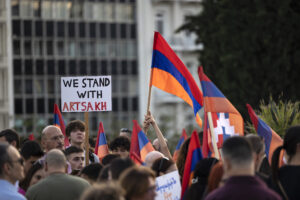
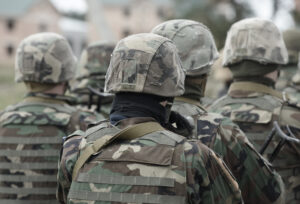
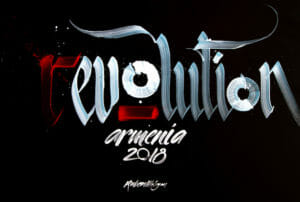
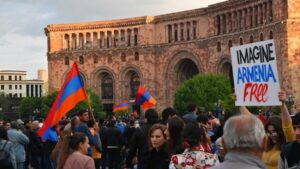


You need to be a supporter to comment.
There are currently no responses to this article.
Be the first to respond.